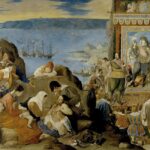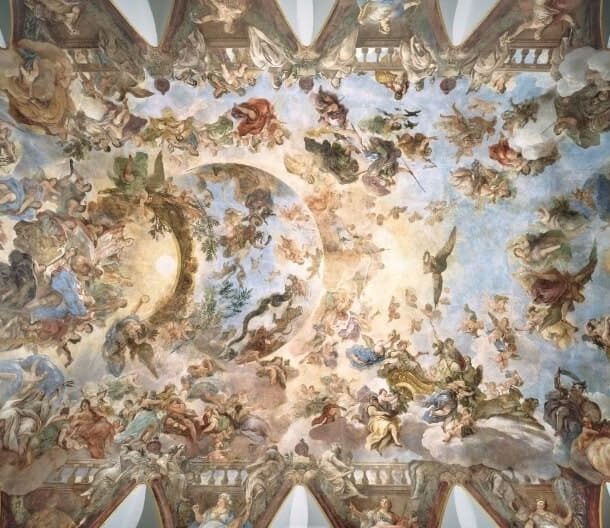
Maíno’s work was executed at the end of 1634. The first 18,600 maravedíes were paid for it, and it was to be destined for the Salón de Reinos. Maíno delivered the work on 16 June, when he received the estimated 200 ducats from Philip IV’s secret expenses. The composition does not follow the traditional patterns that governed the composition of war paintings inspired by Antonio Tempesta’s prints. The only thing in which he was on a par with his colleagues Carducho, Cajés and Leonardo, among others, was the exaltation of the victor, in this case Don Fadrique Álvarez de Toledo, who shared the glory with Philip IV and the Count Duke of Olivares. The composition is divided into different planes. The first of these, located on the right-hand side, shows the horrors of war and the need for aid and assistance to the wounded. The next shot shows Don Fadrique on a stage accompanied by a tapestry depicting Philip IV, the Count Duke and Minerva, crowning the monarch with a Roman-style laurel wreath while he holds the palm which, iconographically, corresponds to Christian martyrdom. King Planeta stands as the conqueror of heresy, defeated at his feet. Meanwhile, Don Fadrique appeals to the king’s justice and mercy in the face of the pleas of the defeated Dutch.
Collection: Images
Project: 5. Power and powers in the history of Europe: oligarchies, political participation and democracy., 6. Under a cloak of terror: violence and armed conflict in Europe.
Chronology: XVII
Scope: Secondary Education, Baccalaureate, University
Resource type: Image
Format: Oil on canvas (309 x 381 cm)
Source: Museo Nacional del Prado (Madrid)
Language: Spanish
Date: 1634-35
Owner: Álvaro Romero González (Modernalia)
Identifier: P000885
Copyright: Museo del Prado (Madrid)
Abstract: Representation of the recovery of Bahía de Todos los Santos, a work that forms part, along with others, of the commemoration of a series of land and naval victories that smiled on the armies of the Hispanic Monarchy during the first period of the Thirty Years' War (1621-30). These canvases were intended for the Salón de Reinos at the Buen Retiro Palace.
Image
Tags






